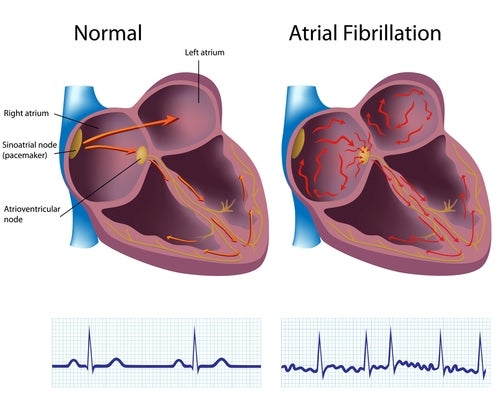September is Atrial Fibrillation Awareness Month.
Atrial Fibrillation (AFib) is one of the most common types of heart rhythm disorders, and it can happen to anyone. It’s characterized by an irregular heartbeat, which occurs when the heart muscles fail to contract in a strong, rhythmic way.
Why is this a big deal?
When your heart enters into an irregular heartbeat or rhythm, it may be a sign that not enough blood is being pumped throughout the body. When this happens, blood can begin to pool inside of the heart, forming a clot. When a blood clot is pumped out of the heart, it can become lodged in your arteries, preventing oxygen-rich blood from getting to vital organs and putting you at a higher risk of stroke. Over time, AFib can cause your heart to weaken and eventually malfunction.
Who does AFib affect?
More than two million Americans are affected by atrial fibrillation, and approximately twenty percent of all strokes are directly attributed to AFib. Typically, older people are more affected by AFib than younger people. Others who are affected include individuals who are overweight or obese as well as some athletes.
Know the Signs/Symptoms of AFib
According to the American Heart Association (AHA), people with AFib are five times more at risk for stroke. Knowing the signs of AFib may help you seek medical help before it’s too late. One of the most common signs of AFib includes a fluttering heartbeat. Other signs of AFib include:
- Fatigue
- Rapid, irregular heartbeat
- Dizziness
- Shortness of breath
- Chest pain or pressure*
*If you experience chest pain, you should seek medical attention immediately.
Read about treatment options for atrial fibrillation.
Know the Risk Factors of AFib
Though AFib can happen to anyone, people who are 65+ years of age are at greater risk. Other risk factors for AFib include:
- Congestive heart failure
- Diabetes
- High blood pressure
- Sleep apnea
- Family history
- Alcohol and/or stimulants
- Coronary artery disease
- Thyroid disorder
- Obesity
Diagnosis & Treatment
At WakeMed, our goal is for all patients to return to an active, healthy lifestyle, and for most AFib patients, this is achievable as along as diagnosis and treatment occur as soon as possible. Our heart and vascular physicians use a painless procedure called electrocardiography (EKG) to diagnose AFib. Once diagnosed, an individual’s treatment may vary according to several factors:
- How long they’ve had atrial fibrillation
- The cause of the atrial fibrillation
- How severe the symptoms are
From there, one of the following treatments may be administered:
- Antiarrhythmic Medication
- Electrical Cardioversion
- Radiofrequency Catheter Ablation
If you fall into a high risk category for AFib, it is important to maintain regular checkups with your healthcare professional. Express your concerns to him/her, and work together to mitigate lifestyle risk factors as well as identify other potential risk areas.

